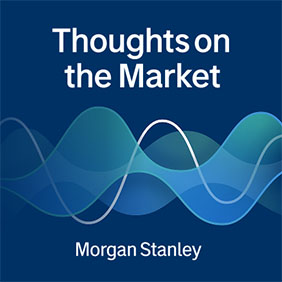The Next Turning Points in Tech
October 22, 2025
Our analysts Brian Nowak, Keith Weiss and Matt Bombassei break down the most important tech insights from Morgan Stanley’s Spark Private Company Conference and industry shifts that will likely shape 2026 and beyond.

Thoughts on the Market
Listen to our financial podcast, featuring perspectives from leaders within Morgan Stanley and their perspectives on the forces shaping markets today.

Up Next
Time for a Bull Market Correction?
Transcript
Welcome to Thoughts on the Market. I'm Mike Wilson, Morgan Stanley's CIO and Chief U.S. Equity Strategist. Today on the podcast I'll be discussing why we are still in a new bull market even if a correction is likely in the near term.
It's Monday, October 20th at 1pm in New York.
So, let's get after it.
I continue to believe the sharp selloff in April following Liberation Day marked the trough of what was effectively a three-year rolling recession in the U.S. economy. We have written extensively about this view; but it still remains very much out of consensus.
Since 2022 most sectors of the private economy have gone through their own individual recession but at different times. The final trough in the rate of change in economic activity came in April around the tariff announcements which came as a surprise to almost everyone, at least in terms of the magnitude and scope.
In short, Liberation Day was really capitulation day on the last piece of bad news for the economic cycle which then bottomed.
Stocks seem to agree which is why they have rallied in a straight line since then, much like they do after the trough in any economic cycle. The other proof we have for this claim is the v-shaped recovery in earnings revision breadth, something we have discussed for many months in our written research and on this podcast.
Based on our numerous conversations with investors, this view remains very unpopular. Instead, most believe the economy and earnings growth for next year are at risk of being lower rather than higher than expected, as I do. Core to my view is that we are now firmly in an inflationary regime since COVID and the implementation of helicopter money to get us out of that crisis. The government has to run it hot, to get us out of the massive debt and deficit problem created over the past 20 years.
The end result is that investors need to expect hotter but shorter cycles rather than the elongated 10-year cycles we experienced between 1980-2020 when inflation was falling. That means two-year up cycles followed by one-year down cycles for U.S. equity markets, which is exactly what's happened since 2020.
We are now in the midst of a new up cycle that began in April. The key thing to understand during this new regime is that inflation is not bad for stocks so long as it's accelerating and the Fed is on the sidelines or easing like in 2020-21, 2023 and now today. Higher inflation means higher earnings growth which is why price earnings multiples are high today. With inflation likely to accelerate next year, stocks are anticipating better earnings growth.
In other words, stocks are a hedge against inflation. In fact, relative to gold, high quality stocks may offer a cheaper inflation hedge at this point given their dramatic underperformance to precious metals year-to-date and since 2021.
Eventually, inflation will be a problem again for stocks like in 2022 when the Fed has to react by tightening policy, but that's a story for another day.
Having said all this, the equity markets are a bit frothy at the moment and so a 10-15 percent correction in the S&P 500 is not only possible but would be normal at this stage of a new bull market. I see three primary reasons for why we could get that in the near term.
First, China-U.S. trade relations have recently escalated again, and we are slowly marching toward a November 1st deadline for tariffs on China to go back to Liberation Day levels. While most investors don't want to get sucked into selling at the worst possible time like they did in April, this risk is real and will weigh on stocks if we don't see evidence of a de-escalation in the next few weeks.
Second, funding markets have exhibited some signs of increased stress lately. This is likely due to the ongoing quantitative tightening program by the Fed which is draining bank reserves. Should these stresses increase, it could spill over into equities.
Third, our earnings revision breadth metric is rolling over now after its historic rise since April. This could continue into earnings season as it's normal to see some retracement from such a high level and tariffs start to flow through from inventories to the income statement. Trade tensions might also weigh on company guidance in the short term.
Bottom line, I believe a new bull market began in April with a new rolling economic and earnings recovery that is now quite nascent. However, even new bull markets have corrections along the way, and certain conditions argue we are at risk for the first tradable one since April.
Keep your powder dry in the near term for what should be a great buying opportunity, if it arrives.
Thanks for tuning in; I hope you found it informative and useful. Let us know what you think by leaving us a review. And if you find Thoughts on the Market worthwhile, tell a friend or colleague to try it out!

U.S.-China Tensions: What Could Happen Next?
Transcript
Ariana Salvatore: Welcome to Thoughts on the Market. I'm Ariana Salvatore, Morgan Stanley's U.S. Public Policy Strategist.
Today I'll talk about a development keeping markets and investors on alert: a re-escalation of U.S. China trade tensions.
It's Friday, October 17th at 10am in New York.
Since April, the U.S. and China have been in what we've been calling a very delicate detente. Remember, President Trump paused the additional reciprocal tariffs after Liberation Day.
Since then, we've been consistently skeptical that the pause was durable enough to actually allow the U.S. and China to come up with a full-fledged trade agreement. But now we're equally as skeptical that the current escalation will lead to a material disruption in the bilateral relationship.
So, what happened last week? China announced stricter export controls on rare earths, which are really critical for manufacturing everything from electric vehicles to defense equipment and advanced electronics. So, in response, the Trump administration on Friday announced a proposed 100 percent tariff, said to go into effect November 1st across all Chinese exports to the U.S. That date matters because that's around the same time that Presidents Trump and Xi were scheduled to meet at the upcoming APEC Summit in South Korea.
When we think about this most recent escalation, it's pretty significant because China accounts for about 70 percent of global rare earth mining, and 90 percent of processing and refining. A lot of countries around the world – the U.S. Japan, Korea, and Germany – all rely heavily on these imports from China. And so potential new export controls mean that every economy may have to start negotiating bilaterally with China to secure supplies, which raises the risk of supply chain disruption across Asia, Europe, and the U.S.
Looking ahead, we're thinking about four potential scenarios for how the current U.S.-China trade tensions could play out. The most likely outcome, which is our base case, is a return to the recent status quo following a period of rhetorical escalation and likely a reset of expectations heading into this APEC meeting. That's because we think both the U.S. and China would prefer to maintain the existing equilibrium to an abrupt supply chain decoupling.
That equilibrium is effectively chips for rare earths. So, the U.S. receives China's rare earths, and then in return the U.S. exports some of its chips to China. But that equilibrium doesn't necessarily mean that the temporary implementation of trade barriers like higher tariffs or more export controls are off the table.
The broader trajectory we think will continue to point toward competitive confrontation, which is a bipartisan strategy that encompasses both these traditional trade tactics as well as unilateral domestic investment – either vis-a-vis direct federal spending, or the government taking more stakes in companies involved in these critical industries. So, think things like the IRA, the CHIPS Act, and other bipartisan pieces of legislation.
So, in the near and medium term, expect to see these trade barriers persisting and a bipartisan push toward U.S. industrial policy, as the U.S. attempts to undergo selective de-risking from China. Our base case scenario anticipates further short-term tensions, but ultimately a limited agreement that avoids deep structural changes.
We've also thought through some alternate scenarios. So, in one downside case, you could see temporary escalation past November 1st. Both sides could fully implement their proposed policies, but after doing so, come back to the status quo once the economic costs become apparent.
A more severe downside scenario involves durable escalation. So, in this case, we would see both countries maintain trade barriers for an extended period. That outcome would see both the U.S. and China decide to change calculus on that equilibrium, so that no longer holds. And in that case, we could see a push toward decoupling and a significant strain on supply chains.
Finally, our last scenario reflects a quick de-escalation in which heightened rhetoric actually acts as a catalyst for renewed negotiations and a potential framework agreement that could result in some tariffs, but most likely at lower levels than initially proposed.
So, what does this all mean? In the base case, our economists expect China's GDP growth to slow to below 4.5 percent in the second half of 2025, with exports supported by robust non-U.S. shipments. Our equity strategists in this outcome see the volatility actually providing a dip buying opportunity, given that they see a rolling recovery that began earlier this year.
However, a more durable escalation could possibly prolong China's deflation and necessitate further policy adjustments. Similarly, that outcome could negate the early cycle rolling recovery thesis here in the U.S.
Thanks for listening. If you enjoy the show, please leave us a review wherever you listen and share Thoughts on the Market with a friend or colleague today.

Sign up to get Morgan Stanley’s Five Ideas newsletter delivered weekly to your inbox.
Subscribed!
Thank you for subscribing to our blog newsletter. Stay tuned to hear about Morgan Stanley ideas!



